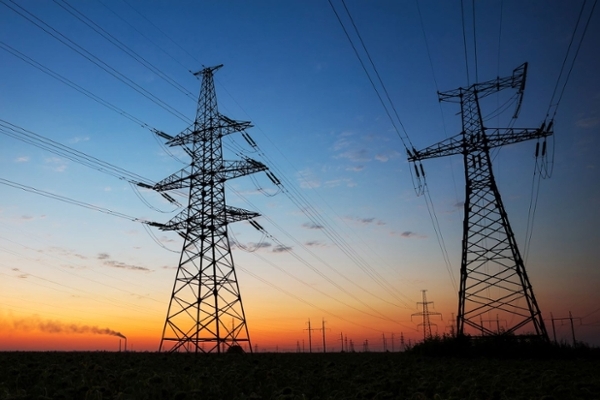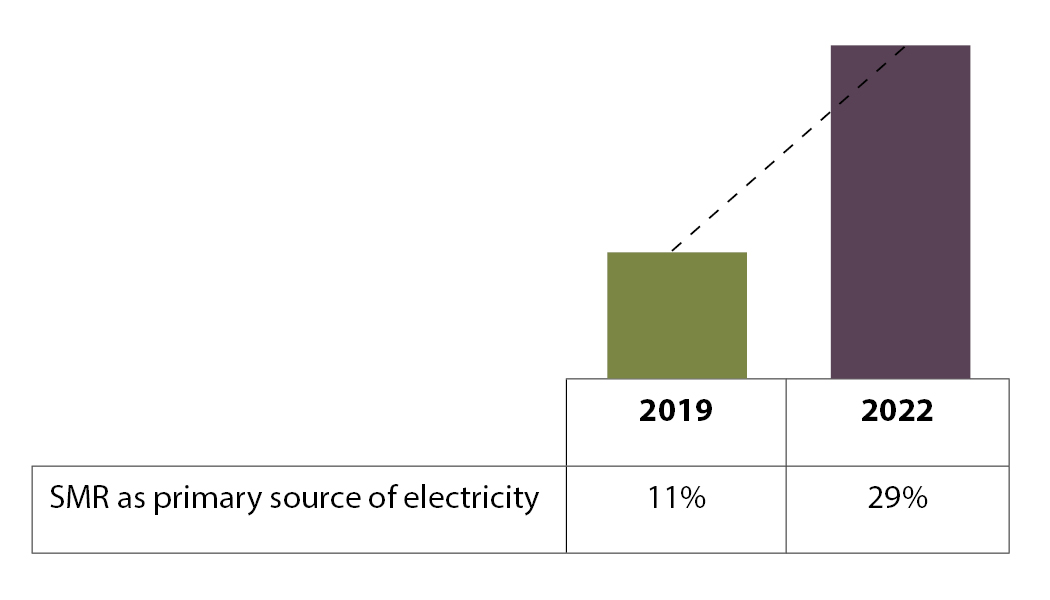
Saskatchewan and the Nuclear Option: Addressing Climate Change through Nuclear Electricity Innovation
The global impacts of climate change have become increasingly evident. Whether it's massive flooding in Pakistan, drought and rapidly declining river flows across Europe and the U.S., more intense hurricane activity, or forest wildfires, the scale of the climate change challenge is coming into a stark focus. So too has the urgent need to address the complex problem of climate change through significant Greenhouse Gas Emission (GHG) reductions.
By Margot Hurlbert, Canada Research Chair in Climate Change, Energy and Sustainability Policy and JSGS Professor; Abimbola Ojo, JSGS PhD Candidate; Francisco Sahagun, JSGS MPP Student; Tanushree Das, JSGS MPP Student; Charisse Vitto, U of R MA StudentDownload the Discussion Questions
The global impacts of climate change have become increasingly evident. Whether it’s massive flooding in Pakistan, drought and rapidly declining river flows across Europe and the U.S., more intense hurricane activity, or forest wildfires, the scale of the climate change challenge is coming into a stark focus. So too has the urgent need to address the complex problem of climate change through significant Greenhouse Gas Emission (GHG) reductions.
In Saskatchewan, a province rich in natural resources including oil, gas, potash, and uranium, the challenge can be seen as both daunting and an opportunity. Daunting in the sense that the foundation for Saskatchewan’s economy is the mining, oil and gas, and agriculture sectors, and an increasingly diverse industrial base that consumes 70 per cent of the electricity produced in the province. Clearly, transitioning away from an electrical generation fleet consisting of 65 per cent carbon-emitting technologies will be no small feat. Importing electricity from neighbouring provinces and building more wind and solar are important strategies. But realistically they will not be enough. To reach the goal of a net zero future by 2050 will require secure and reliable baseload power that can be immediately accessed when intermittent renewable sources such as wind and solar are not available. That’s the challenge.
The opportunity for Saskatchewan, which has one of the world’s richest storehouses of uranium, is reflected in the growing consensus that emissions-free nuclear power must be part of the global climate solution. In October 2022, Saskatoon-based uranium mining giant Cameco announced its intent to purchase 49 per cent of Westinghouse Electric Company, which is a leader in the development of new nuclear power technology. The other 51 per cent is being acquired by Toronto-based Brookfield Renewable Partners. The leading edge of nuclear power’s re-emergence as a necessary option is the next wave of nuclear innovation in the form of Small Modular Reactors (SMRs), from many companies, including Westinghouse. Further evidence of nuclear’s strategic importance to Saskatchewan was Cameco’s recent announcement of a 12-year uranium supply contract to fuel Ukraine’s massive nuclear power sector, which totals 15 reactors. Cameco will be filling demand previously supplied by Russia before it invaded Ukraine last year.
Small Modular Reactors (SMRs) could be the future of Canada’s nuclear industry. They have the potential to provide non-emitting energy for a wide range of applications, from grid-scale electricity generation to use in heavy industry, for district heating and powering off-grid remote/northern communities and mines.
Canada and Saskatchewan have been actively considering this option. In 2018, led by Natural Resources Canada, the federal government convened experts from across Canada in industry, government, utilities (including SaskPower), and other enabling partners to “chart a vision for the next wave of nuclear innovation.” Through expert working groups, including initial engagement with northern Indigenous communities and organizations and workshops held across Canada, the roadmap initiative gathered feedback on direction for the possible development and deployment of SMRs in Canada. The resulting roadmap fostered a national conversation about the needs and the priorities of Canadians, and identified key issues around the use of SMRs, including risks and challenges.
Subsequently, as a result of the pan-Canadian effort bringing together key enablers from across the country, the Minister of Natural Resources Canada in 2020 released Canada’s Small Modular Reactor (SMR) Action Plan. In all, 110 Organizations submitted 450 action items to be led by Indigenous people, municipalities, governments, power utilities, academia, research, and heavy industry. In its April 2022 budget, the Government of Canada signalled its support for the development of SMRs. The budget noted: “Canada’s nuclear industry is well positioned to leverage its more than 60 years of science and technology innovation to become a leader in the development and deployment of small modular reactor technology.”
It is clear that support for SMRs in Saskatchewan is building. A survey conducted in 2019 by the Centre for the Study of Science and Innovation Policy, of Johnson Shoyama’s Graduate School of Public Policy, asked people to identify what they believed would be the primary source of electricity in Saskatchewan 10 years from now. Of the 1,104 people surveyed, 11 per cent identified SMRs. When this survey was repeated in 2022, 29 per cent of people taking the survey identified SMRs.
Graph 1: Citizen Perception on SMR as Primary Source of Electricity

The same is true nationally. In a 2021 survey by Abacus, data found growing support for SMRs. When respondents were informed that SMRs have the capacity to bring non-emitting electricity and heat production to remote communities and industrial extraction sites, and be added as electricity demand grows, it found that 63 percent support SMRs, and are open to support government investment in SMRs (16 per cent strongly support, 24 per cent support, and 23 per cent are open to support).1
In a September 2022 Canada-wide survey, IPSOS Research found that the greatest familiarity and support for nuclear power was in Ontario. In that province, where nuclear power has long been the mainstay of electricity generation, 58 percent said they were familiar with nuclear power, and 52 per cent supported it.
The Safety Issue
Despite growing levels of public opinion support and subsequent publicity for the development of SMRs, many questions remain for some. Chief among them is safety. In the same IPSOS poll, 53 per cent of Canadians said they were “very” or “somewhat” concerned about nuclear power safety.2 This policy brief addresses those questions.
For competitive reasons, some SMR developers remain tight-lipped. But provinces cooperating on their development (Ontario, New Brunswick, Alberta, and Saskatchewan), and the Canadian Nuclear Regulator have required information to be public for decision-making and licensing. In a series of public, stakeholder, and rightsholder engagements concerning the complex problem of climate change and power production sources in the future, three predominant questions have emerged:
- What are the safety features of these SMR designs?
- Does the operation of SMRs have any effect on water?
- What are the plans for radioactive waste?
SMRs are a new generation of nuclear reactors designed to generate heat and are typically used for electric power (typically up to 300MW). Their components and systems can be shop fabricated and then transported as modules to power generation sites.3 All of the SMR designs adopt advanced inherent safety features. While there are several different varieties of SMR designs, two, the Hitachi BWRX-300 model and the Westinghouse eVinci are being considered for deployment in Saskatchewan by SaskPower and Saskatchewan Research Council, respectively, although other models may also have application in Saskatchewan.
Currently under consideration by SaskPower, the General Electric Hitachi BWRX-300 model, is termed a boiling water reactor (BWR) and will have approximately 300MWe power output. The reason it is termed a BWR is because the reactor boils water in its reactor core, and then transfers that steam directly to a turbine. The BWRX-300 employs natural circulation (not externally powered) for its main cooling and backup cooling processes, and uses a closed-loop system of light water as a coolant. The BWRX-300 refuelling cycle is 12 – 24 months and the reactor uses enriched uranium at 4.95% maximum [1].
The Westinghouse eVinci model, under consideration by the Saskatchewan Research Council (SRC), is much smaller with a 2-3.5 MWe Power Output. It is a Micro reactor, contains a Monolithic core with heat pipe technology, a greater than 36 months fuel cycle, and uses enriched uranium between 5-19.5%. The eVinci can provide heat and power to remote communities and mines, and offers a black start service (kick starts an electric grid after complete loss of power in the grid).
Concern #One: Main Safety Features
To improve safety, SMRs employ numerous passive safety features and shut down in the event of external stress without the requirement of human intervention.
BWRX-300 Model: If external power is lost or the reactor is tripped, the BWRX-300 is able to passively cool itself for 7 days without power or an operator, and can cool indefinitely by adding water (no power required). Like all BWRs, the BWRX-300 utilizes a Rankine steam-cycle containing boiler, a turbine driven by the steam produced by the boiler, and a condenser cooled by an external water source.
Unlike current operating BWRs, the BWRX-300 utilizes natural circulation (instead of large mechanical pumps) to drive coolant flow through the reactor and relies on purely passive systems for emergency cooling. The systems are termed “passive” because no operator interaction is required, and the system is driven by natural processes (e.g., a heat rejection system that operates via natural circulation with no mechanical/electrical pumping). A passive safety system reacts automatically to an abnormal event reducing its effect without the need for any human intervention.
Natural circulation is not new to nuclear reactors. The BWRX-300 relies on past experience and licensing for its safety features. For example, the Dodewaard BWR in the Netherlands, which operated from 1969 – 1997, was a BWR that operated on the principle of natural circulation for main cooling. Experience gained from that reactor was incorporated in the GE-Hitachi 1600 MWe Economic Simplified Boiling Water Reactor (ESBWR), which also employed natural circulation, and the design was certified by the US nuclear regulator in 2014 after a rigorous licensing process.
Emergency cooling comes first from an Isolation Condenser System (ICS) which removes decay heat directly from the reactor core using an outside water source. The ICS tubes condense steam from the reactor pressure vessel on the inside surface and transfer heat on the outside surface to the Isolation Condenser Pool, venting steam to the atmosphere.
Secondly, the Passive Containment Cooling System (PCCS) removes decay heat and maintains pressure limits. The ICS and PCCS water do not mix. As a result, the BWRX core can be entirely cooled by natural circulation during normal operations and should accident conditions arise. Indefinite cooling can be achieved with only the addition of water.
eVinci Model: The eVinci reactor is very small (2-3.5MWe) and eliminates many traditional accident scenarios as it doesn’t use water or employ high-pressure systems like current large reactors. Thus it has no high-pressure systems to fail. In the case of decay heat, the Monolithic core within the reactor canister, coupled with passive heat pipes, allows heat removal by natural processes to the outer sections of the reactor canister passively allowing heat transfer to the air. If external power is lost or the reactor is tripped through its autonomous control system, control drums automatically rotate to a position of high neutron absorption around the Monolithic core and shut down the reactor.
Furthermore, the use of TRISO (TRi-structural ISOtropic particle) fuel is a significant safety feature as this fuel cannot melt under postulated accident conditions, and can withstand extreme temperatures beyond the limits of traditional fuels.4 Indefinite cooling is achieved without operator interaction and no water or power is ever required.
Concern #Two: Water Cycle
The Hitachi model’s core can be cooled entirely by natural circulation, using a closed direct-cycle design in which steam from the reactor is supplied directly to the turbine, and then a condenser is used to cool the steam and send the same water back to the reactor. The condenser cooling water is provided from an external water body. Reactor water and condenser cooling water do not mix. The water that is converted to steam in the reactor is part of a closed loop that never enters the environment. In an emergency (eg. condenser cooling not available) the reactor automatically shuts down and then the Isolation Condenser System (ICS) automatically starts and uses reactor water to provide passive shut-down cooling by transferring heat to an isolated open pool of clean water (the water pool and reactor water do not mix) which releases heat by generating steam from the pool water. Water bodies external to the SMR are not impacted any differently than they are by traditional thermal power plants. The Westinghouse eVinci Micro reactor model does not use any water cooling.
Concern #Three: Waste Management
A crucial issue in any consideration for the development of nuclear power is how to deal with waste. The 2002 Nuclear Fuel Waste Act formed The Nuclear Waste Management Organization (NWMO) which is responsible for designing and implementing Canada’s plan for the safe, long-term management of used nuclear fuel. The NWMO has been operating since 2002, and in 2010 started site selection for a deep geological repository. Two communities in Ontario have been identified.
In November 2020, the Government of Canada began the process to modernize Canada’s policy for radioactive waste, with a new policy expected in 2023.5 At the same time, the NWMO has been engaging across the country on a new Integrated Strategy for Radioactive Waste.6
The BWRX-300 will generate less spent fuel per MWe output than current nuclear power plants in Ontario and New Brunswick. The eVinci reactor proposes to have no spent fuel or waste storage on-site during the reactor operations. The reactor contains all its waste which will be shipped to a processing facility at the end of the reactor lifetime.
Canada’s nuclear spent fuel is stored at the site of the nuclear power generation facility (similar to mining and industrial waste tailing sites). Funded by waste owners, for the past decade, the NWMO has been planning Canada’s deep geological repository for disposing spent fuel. Two sites have been identified for eventual disposal: Wabigoon-Ignace, and the Son-South Bruce area. Finland, Sweden, are two well advanced in identifying geological sites and the U.S. has just embarked on a new similar process.
The Westinghouse eVinci typically has lifetime core loading, such that there is no storage in the plant. Most micro reactors propose fuel will be handled by a central facility.
Conclusion
Regulatory reviews for these SMR designs are well underway in Canada and around the world. The policy window is clearly open given climate change and the federal government’s commitment to achieve net zero emissions by 2050 enshrined in the Canadian Net-Zero Emissions Accountability Act. Ontario Power Generation just submitted a construction license application7 for a BWRX-300. and the Westinghouse eVinci model is in Phase 2 of Pre-licensing Vendor Design Review Assessment8 in Canada. Ontario Power Generation is the proponent of the Hitachi BWRX-300 in its Darlington, Ontario site with completion anticipated in 2028. Other countries similarly considering this technology include Estonia, Sweden, Poland, and the USA. The Tennessee Valley Authority, U.S.A. is also exploring a BWRX-300 Hitachi model and the American and Canadian regulators have a memorandum of cooperation for SMRs.
Successful actualization of these projects and their applicability in Saskatchewan (a ‘greenfield’ site without previous nuclear power generation) is by no means assured. Every licensing and environmental review requires active public involvement in all stages and consultation with Indigenous rights holders. While the climate change problem has opened a new public policy stream for nuclear, there is still uncertainty in the politics stream in Saskatchewan. Avoiding Saskatchewan’s nuclear power public engagement history of the Perrins’ consultation (2009) should be a priority. Largely consisting of a series of town halls around Saskatchewan with open microphones this consultation came too late after the release of the Uranium Development Partnership report in 2008. Active, pre-decision, transparent, public engagement emphasizing full context thinking weighing all alternatives fairly, is a policy process for positive public judgement of advancing net zero climate change plans.
Prudently, SaskPower is actively moving forward on the SMR file and stated that its ‘shovel ready’ construction decision will be made by the end of 2029. In the meantime, SaskPower’s projects to address climate change include importing more power from its neighbours in Manitoba and the U.S.A., and acquiring more renewable capacity. With Camecos’s proposed 49 per cent stake in Westinghouse, and 49 per cent stake in Global Laser Enrichment, the next several years will determine if Saskatchewan’s landscape will embrace the entire nuclear supply chain and fuel cycle.
References
1 https://www.ans.org/news/article-2655/canadian-survey-reveals-solidsupport-for-nuclear-investment/
3 IAEA. 2020. Advances in Small Modular Reactor Technology Developments. 2020th ed. https://aris.iaea.org/Publications/SMR_Book_2020.pdf
4 https://www.energy.gov/ne/articles/triso-particles-most-robust-nuclearfuel-earth
5 https://www.rncanengagenrcan.ca/en/collections/modernizing-canadasradioactive-waste-policy
6 https://radwasteplanning.ca/
7 https://www.rncanengagenrcan.ca/en/collections/modernizing-canadasradioactive-waste-policy
8 Safety Commission, Canadian Nuclear. 2014. “Pre-Licensing Vendor Design Review.” February 3, 2015
Margot Hurlbert

Margot Hurlbert is Canada Research Chair in Climate Change, Energy and Sustainability Policy at the Johnson Shoyama Graduate School of Public Policy at the University of Regina, Canada. Margot’s scholarship concerns climate change, energy, Indigenous peoples, water, droughts, floods, water governance and sustainability.
Margot has led and participated in many academic and industry funded research projects, serves on the editorial boards of international journals, and is a Senior Research Fellow of the Earth Systems Governance Project. Margot was Coordinating Lead Author of a chapter of the Special Report of the Intergovernmental Panel (“IPCC”) on ‘Climate Change on Land’ (2019) and a Review Editor and Contributing Author for the IPCC’s AR6 (WGI and WGII)(2021/2022). She also works on Future Earth’s Earth Commission Working Group on Transformations (2019-2022) and is the Principal Investigator of a project investigating the gap in water adaptation in Canada and South America.
Tanushree Das

Tanushree Das, a development practitioner from Bangladesh with an academic background in Information Technology (IT), is an MPP candidate at JSGS. She has a bachelor’s degree in IT from Gujarat Technological University (India). After working as a deputy manager (Microfinance) of BRAC, Bangladesh, she joined JSGS aiming to gain a deeper understanding of the inclusion of marginalized populations’ interests in the policy formulation process. Her research interests focus on the use of technology in governmental interventions and inclusive organizational development.
Abimbola Ojo

Abimbola Ojo is a PhD Candidate in the Public Policy program at the University of Regina. Her primary research interests are in social/political constraints to the adoption of nuclear innovation and other clean energy sources, climate change/sustainability issues and financing of clean energy. She holds a Bachelor’s degree in Economics, Master’s degree in Energy Economics and has over a decade of work experience in energy industry in Africa, the UK and Canada.
Francisco Sahagun

Francisco Sahagun is a student in the Master of Public Policy program at the University of Regina. His primary interest is clean energy sources, sustainability, social behavior, and technology. He has a transdisciplinary background: a Bachelor’s degree in Chemical Engineering and a Master’s degree in Business and Economic Studies, and has participated in research related to renewable energy.
Charisse Vitto

Charisse Vitto is pursuing a course-based Master of Arts in Social Studies at the University of Regina. Additionally, she holds a Master’s degree in Sociology and a Bachelor’s degree in Psychology. She also works at the Johnson Shoyama Graduate School of Public Policy as a quantitative student research assistant.


